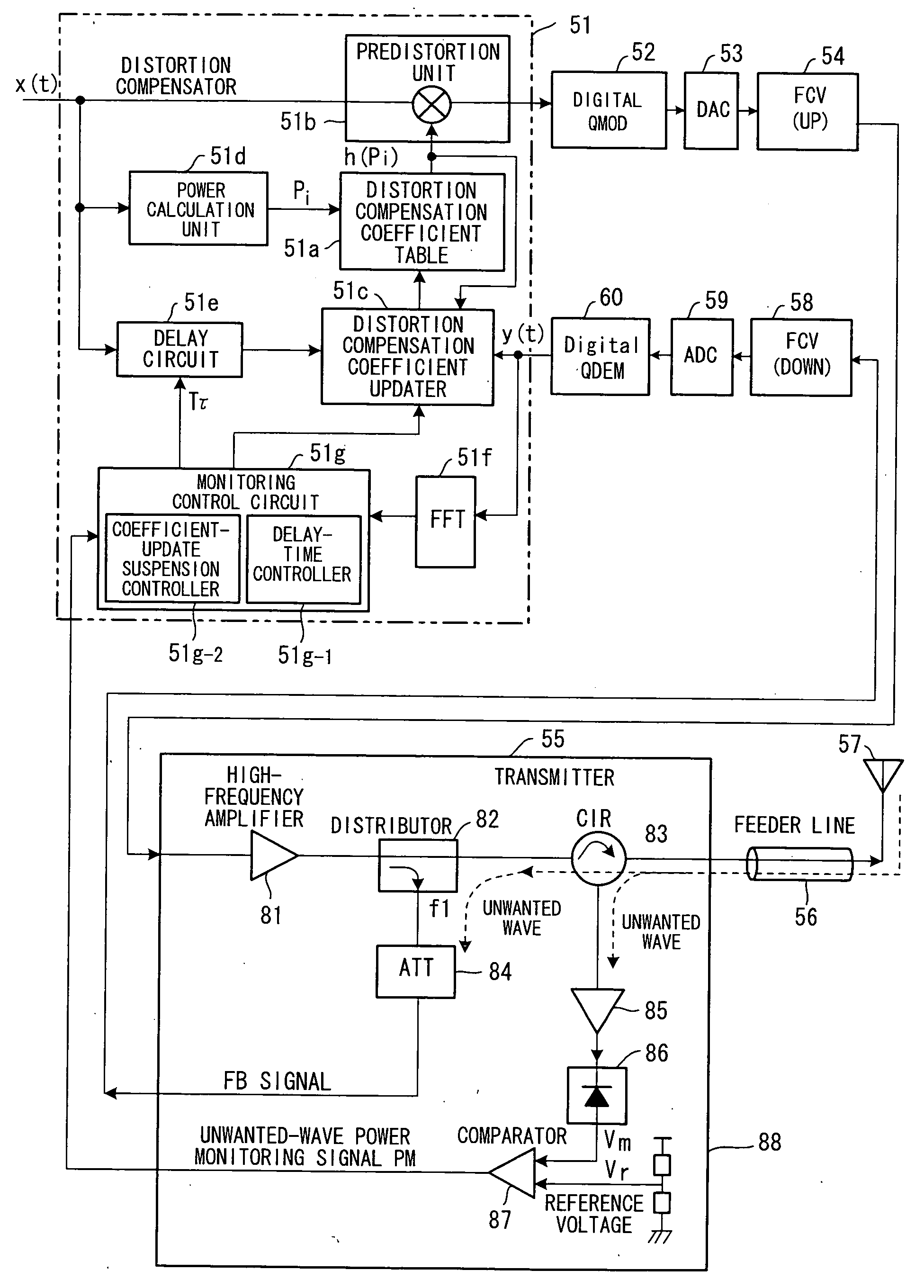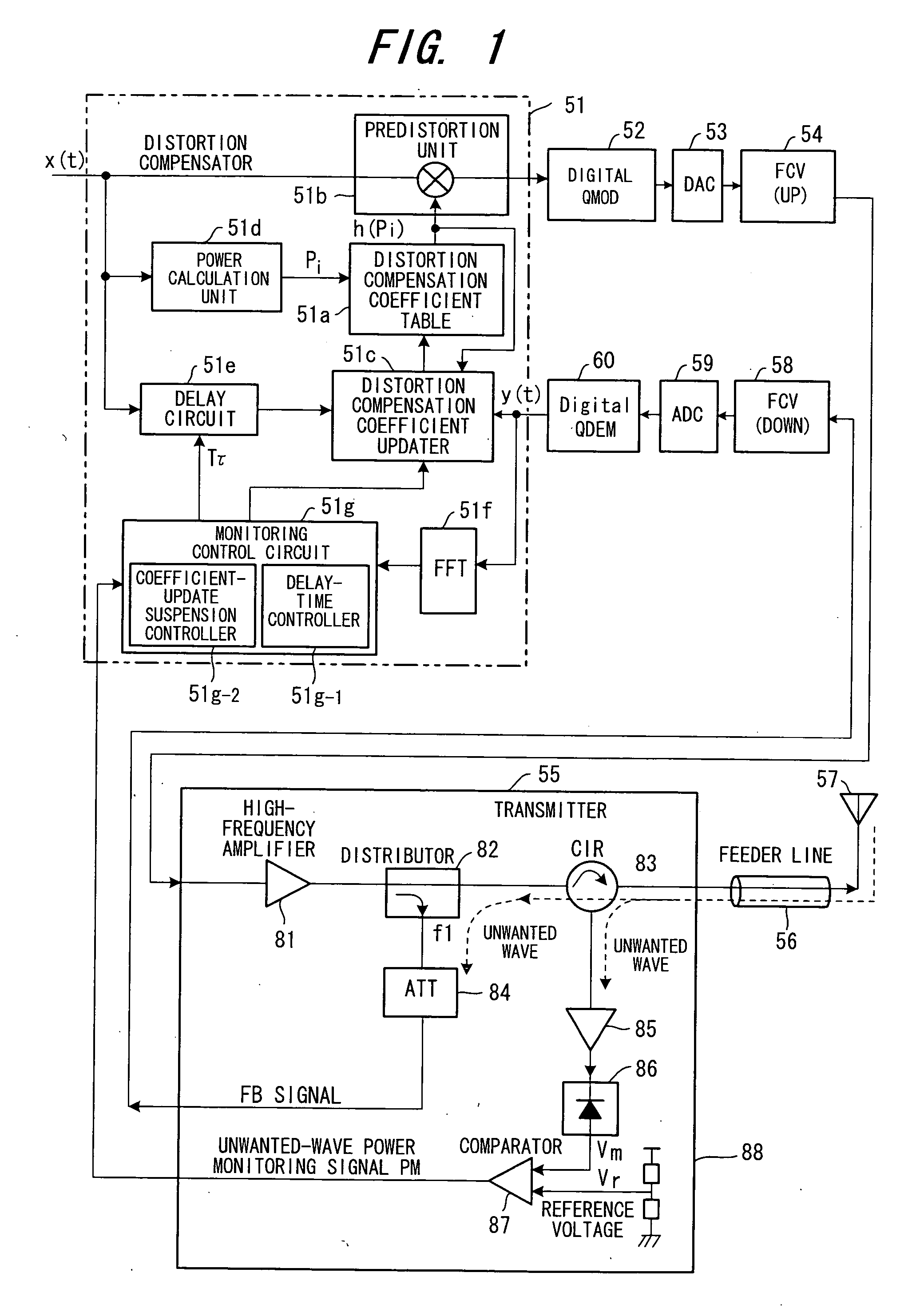Distortion compensating amplifier
a distortion compensation and amplifier technology, applied in the direction of duplex signal operation, transmission monitoring, baseband system details, etc., can solve the problems of affecting the quality of communication of these channels, inconvenient in terms of cost and apparatus size, and unwanted wave on the antenna side of distortion compensation control
- Summary
- Abstract
- Description
- Claims
- Application Information
AI Technical Summary
Benefits of technology
Problems solved by technology
Method used
Image
Examples
first embodiment
(B) First Embodiment
[0048]FIG. 1 is a block diagram illustrating a distortion compensating amplifier according to a first embodiment having a digital distortion compensating function. The distortion compensating amplifier includes a distortion compensator 51, a distortion compensation coefficient memory (distortion compensation coefficient table) 51a, a predistortion unit 51b, a distortion compensation coefficient updater 51c, a power calculation unit 51d, a delay circuit 51e, an FFT (Fast-Fourier Transform) unit 51f and a monitoring control circuit 51g.
[0049] The distortion compensation coefficient table 51a stores distortion compensation coefficients h(pi) (i=0˜1023) conforming to power levels pi of the transmit signal x(t), and the predistortion unit 51b subjects the transmit signal to distortion compensation processing using a distortion compensation coefficient h(pi) that is in conformity with the power level of the transmit signal. The distortion compensation coefficient upda...
second embodiment
(C) Second Embodiment
[0063]FIG. 4 is a block diagram illustrating a distortion compensating amplifier according to a second embodiment having a digital distortion compensating function. Components identical with those of the first embodiment shown in FIG. 1 are designated by like reference characters. This embodiment differs in that (1) the comparator 87 and reference-voltage setting unit 88 are deleted from the transmitter 55 and a signal obtained by rectifying the unwanted-wave signal is input to the distortion compensator 51; (2) the distortion compensator 51 is provided with an AD converter 51h, whereby the rectified unwanted-wave signal is converted to digital data and the digital data is input to the coefficient-update suspension controller 51g-2 of the monitoring control circuit 51g; (3) the transmit-signal power pi is input to the coefficient-update suspension controller 51g-2; and (4) the coefficient-update suspension controller 51g-2 executes control for suspending coeffic...
third embodiment
(D) Third Embodiment
[0073]FIG. 6 is a block diagram illustrating a distortion compensating amplifier according to a third embodiment having a digital distortion compensating function. Components identical with those of the first embodiment shown in FIG. 1 are designated by like reference characters. This embodiment differs structurally in that the transmitter 55 is provided with a signal changeover unit 89 so that the high-frequency amplified signal output from the high-frequency amplifier 81 and an unwanted-wave signal output from the amplifier 85 are input to the distortion compensation coefficient updater 51c and FFT unit 51f selectively via the frequency converter 58, AD converter 59 and digital demodulator 60.
[0074]FIG. 7 is a flowchart of control processing by the monitoring control circuit 51g according to the third embodiment.
[0075] The monitoring control circuit 51g generates a switch signal SW at a predetermined period, thereby causing the signal changeover unit 89 to al...
PUM
 Login to View More
Login to View More Abstract
Description
Claims
Application Information
 Login to View More
Login to View More - R&D
- Intellectual Property
- Life Sciences
- Materials
- Tech Scout
- Unparalleled Data Quality
- Higher Quality Content
- 60% Fewer Hallucinations
Browse by: Latest US Patents, China's latest patents, Technical Efficacy Thesaurus, Application Domain, Technology Topic, Popular Technical Reports.
© 2025 PatSnap. All rights reserved.Legal|Privacy policy|Modern Slavery Act Transparency Statement|Sitemap|About US| Contact US: help@patsnap.com



